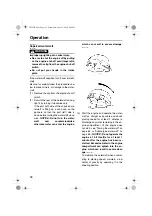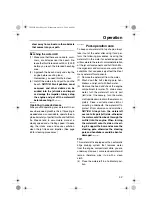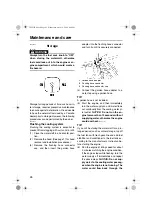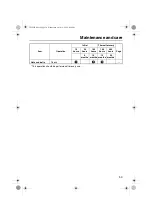
Operation
37
understand where you are going. Avoid
areas with submerged objects or shal-
low water.
●
Take early action to avoid collisions. Re-
member, watercraft and other boats do
not have brakes. Do not release the
throttle lever when trying to steer away
from objects—you need throttle to steer.
The watercraft is less stable when at a stand-
still or at a slow speed. It takes skill to keep the
watercraft upright when starting.
Even though it is easier to start in shallow wa-
ter, you must learn deep-water boarding first.
You will inevitably fall off, so be sure you know
how to get back on the watercraft once you
are away from shore.
EJU33102
Boarding and starting in shallow water
Be sure to learn the deep-water starting meth-
od before operating the watercraft in water
where it is too deep for you to stand. (See
page 38 for the deep-water starting method.)
(1) Launch the watercraft in water free from
weeds and debris and at least 60 cm (2 ft)
deep from the bottom of the watercraft.
NOTICE:
Never operate in water that is
less than 60 cm (2 ft) deep from the
bottom of the watercraft, otherwise
pebbles or sand could be sucked into
the jet intake, causing impeller dam-
age and engine overheating.
[ECJ00471]
(2) Attach the engine shut-off cord (lanyard)
to your left wrist, and then attach the clip
to the engine shut-off switch.
(3) Grip the handlebars with both hands.
Place one knee on the riding tray and bal-
ance there.
(4) Start the engine and begin to accelerate.
(5) Pull your other knee up onto the riding
tray as the watercraft speed increases.
(6) Move as far forward as possible without
interfering with the movement of the han-
dlebars. Keep your body perpendicular to
the water, with your weight forward and
low.
TIP:
The watercraft will become easier to balance
as the speed increases, because jet thrust
provides stability as well as directional control.
UF2F21E0.book Page 37 Wednesday, April 16, 2008 8:40 PM










































